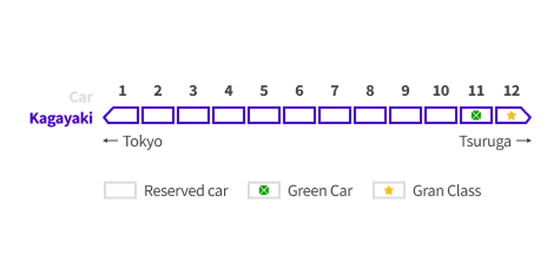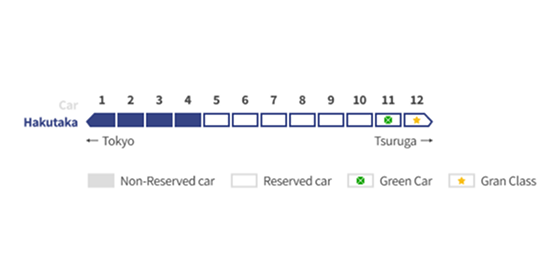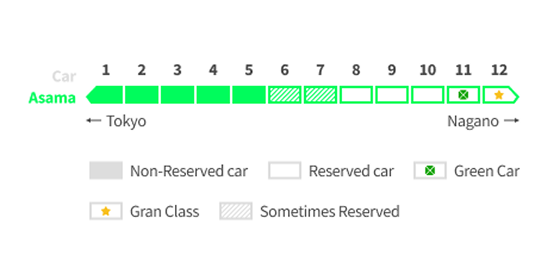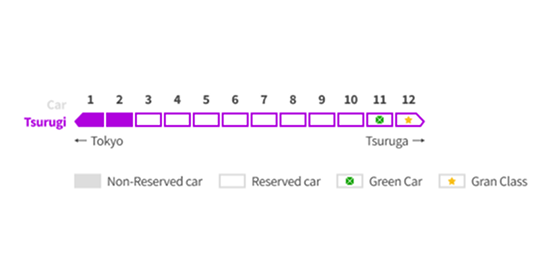The Hokuriku Shinkansen line is an extension of the Nagano Shinkansen line. Since 2015, it has offered a quick and easy way to travel from Tokyo to Kanazawa.
You can use your JR Pass on the Hokuriku Shinkansen line to visit Kanazawa’s top attractions, including the Kenrokuen Garden, Ninjadera Temple, Oyama Shrine, Omicho Market, and the Nagamachi samurai district.
The Hokuriku Shinkansen line also extends from Kanazawa to Tsuruga, taking just over 3 hours from Tokyo.
Below, you can find all the information you need to plan a journey on the Hokuriku Shinkansen with your JR Pass or one of the regional passes.
Table of Contents
Hokuriku Shinkansen Map and Route
Below is a map showing the Hokuriku Shinkansen line and the different routes you can take, depending on your travel plans.

Hokuriku Shinkansen Stops
The main stations along the Hokuriku Shinkansen line are Tokyo Station, Nagano Station, and Kanazawa Station.
Additional stations along this line include:
- Ueno
- Omiya
- Kumagaya
- Honjowaseda
- Takasaki
- Annakaharuna
- Karuizawa
- Sakudaira
- Ueda
- Iiyama
- Joetsumyoko
- Itoigawa
- Kurobe-Unazuki Onsen
- Toyama
- Shin-Takaoka
- Komatsu
- Kaga Onsen
- Awara Onsen
- Fukui
- Echizen-Takefu
- Tsuruga
If you wish to bypass the smaller stations along your route, consider reserving a seat on the Kagayaki express train. The Hakutaka also bypasses many stations between Tokyo and Nagano.
Train Services
You can use the Hokuriku Shinkansen to travel to Nagano, Kanazawa, Toyama, and a number of other destinations. Consider the following train services connecting Tokyo, Nagano, Kanazawa, and Tsuruga.
Kagayaki Shinkansen
Stops: Tokyo – Ueno – Omiya – Nagano – Toyama – Kanazawa – Komatsu – Kaga Onsen – Awara Onsen – Fukui – Echizen-Takefu – Tsuruga
The Kagayaki is the fastest train on the Hokuriku Shinkansen line. This train stops from Tokyo to Kanazawa in Ueno Station, Omiya Station, Nagano Station and Toyama Station.
The journey from Tokyo to Kanazawa will take you less than 2.5 hours. The train operates at 260 km/h (160mph). The Kagayaki features only reserved seats, in both its green class and the luxury Gran Class cars.

Hakutaka Shinkansen
Stops: Tokyo – Ueno – Omiya – Takasaki – Karuizawa – Sakadaira – Ueda – Nagano – Iiyama – Joetsu-Myoko – Itoigawa – Kurobe-Unazukionsen – Toyama – Shin-Takaoka – Kanazawa – Komatsu – Kaga Onsen – Awara Onsen – Fukui – Echizen-Takefu – Tsuruga
Hakutaka makes more stops between Tokyo and Kanazawa than the Kagayaki (less than 3 hours). The operating speed of Hakutaka is 260 km/h (160 mph).
About 1 in 3 Hakutaka trains travels all the way to Tsuruga. They stop at every station along the route from Kanazawa to Tsuruga.

Asama Shinkansen
Stops: Tokyo – Ueno – Omiya – Kumagaya – Honjo-Waseda – Takasaki – Annaka-Haruna – Karuizawa – Sakudaira – Ueda – Nagano
The Asama takes its name from Mount Asama, an active volcano near Karuizawa.
Two train types operate the Asama train services: 8-coach and 12-coach train sets. Both are non-smoking trains with reserved and non-reserved seating space, Green Cars, and wheelchair space.

Tsurugi Shinkansen
Stops: Toyama – Shin-Takaoka – Kanazawa – Komatsu – Kaga Onsen – Awara Onsen – Fukui – Echizen-Takefu – Tsuruga
The Tsurugi train serves as the main connection between Toyama and Kanazawa. The Tsurugi uses 12-coach trains, 3 of which are not in use currently. 1 of the 12 cars is a Green Car (first class).
The majority of Tsurugi trains run between Toyama and Tsuruga, with a small number running just between Kanazawa and Tsuruga.
Most trains stop at every station, but stopping patterns vary by train.

Hokuriku Shinkansen Timetable
Check the table below for the first and last trains stopping at each station.
| Station | First Train (towards Tsuruga) | Last Train (towards Tsuruga) |
| Tokyo | 06:28 (Hakutaka – via Nagano) | 22:08 (terminates at Nagano) |
| Ueno | ~06:30 (shortly after Tokyo’s first) | ~22:10 (a few minutes after Tokyo’s last) |
| Ōmiya | ~06:55 (follows departure from Tokyo) | ~22:35 (aligned with Tokyo’s last) |
| Nagano | 08:08 (train from Tsuruga via Kanazawa) | 23:52 (final terminating train) |
| Kanazawa | 06:02 (Kagayaki non‑stop to Tokyo) | 21:35 (final departure to Nagano) |
| Tsuruga | 06:11 (first Tsurugi to Tokyo via Kanazawa) | 22:28 (final service to Kanazawa, then Toyama) |
Hokuriku Shinkansen Ticket Prices
Below is an overview of ticket prices doe the Hokuriku Shinkansen line.
| Route | Ordinary Reserved Seat | Green Car (1st Class) | Gran Class |
| Tokyo → Tsuruga | ¥15,970 – ¥16,360 | ¥21,150 – ¥21,540 | ¥27,410 – ¥27,800 |
| Tokyo → Kanazawa | ¥14,180 – ¥14,600 | ¥19,370 – ¥19,790 | ¥25,630 – ¥26,050 |
| Tokyo → Nagano | ¥8,340 | ¥11,840 | ¥15,690 |
| Nagano → Kanazawa | ¥8,230 | ¥10,870 | ¥13,730 |
| Kanazawa → Tsuruga | ¥3,770 | ¥5,240 | N/A (Gran Class not available) |
Tokyo to Kanazawa by Hokuriku Shinkansen
From either Tokyo Station or Nagano Station, you can take the express train Kagayaki or the Hakutaka to Kanazawa Station. The Kagayaki typically departs during morning and evening hours.
The trip from Tokyo to Kanazawa takes only 2.5 hours on the express train or about 3 to 3.5 hours on the non-express train.
If using this train, make your seat reservations in advance. If all seats are booked, standing tickets can be purchased.
An additional train called the Tsurugi operates on this line between Kanazawa Station and Toyama Station. The Tsurugi trains do not connect to Tokyo or Nagano and cater mostly to local traffic commuting between the 2 cities.
JR Pass for Hokuriku Shinkansen
Passage on the Hokuriku Shinkansen is covered by the Japan Rail Pass, as well as Hokuriku Arch Pass.
You can activate your JR Pass in many train stations, including the Travel Service Centers in Nagano and Tokyo Station, and the Nippon Travel Agency branch at Kanazawa Station.
If you wish to make a seat reservation, visit a ticketing office within the train station. Give the staff member your desired destination and present your JR Pass.
Once you have your JR Pass in hand, you’re ready to travel on the Hokuriku Shinkansen line!
